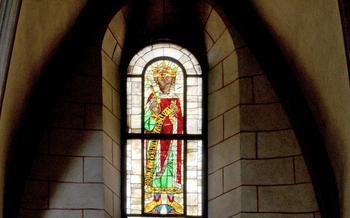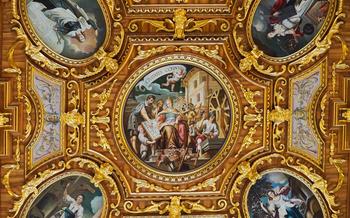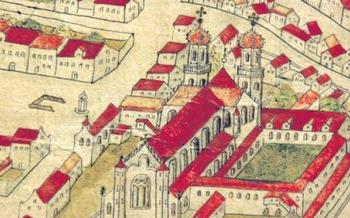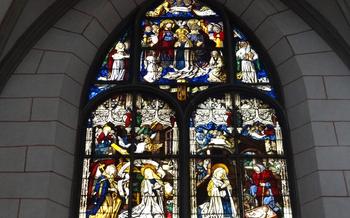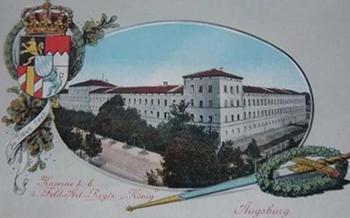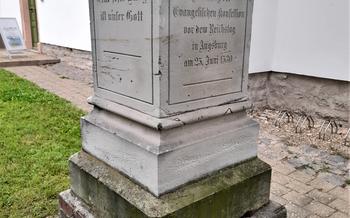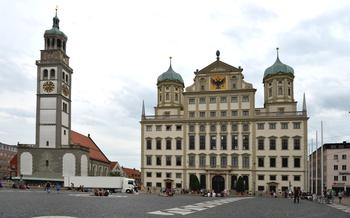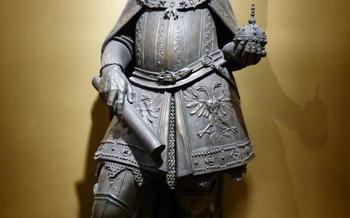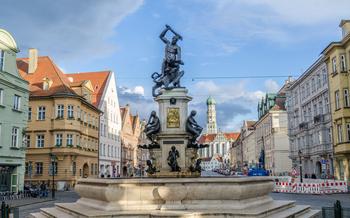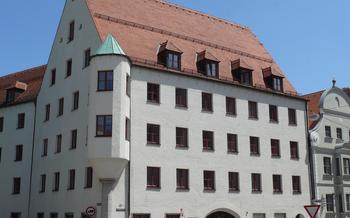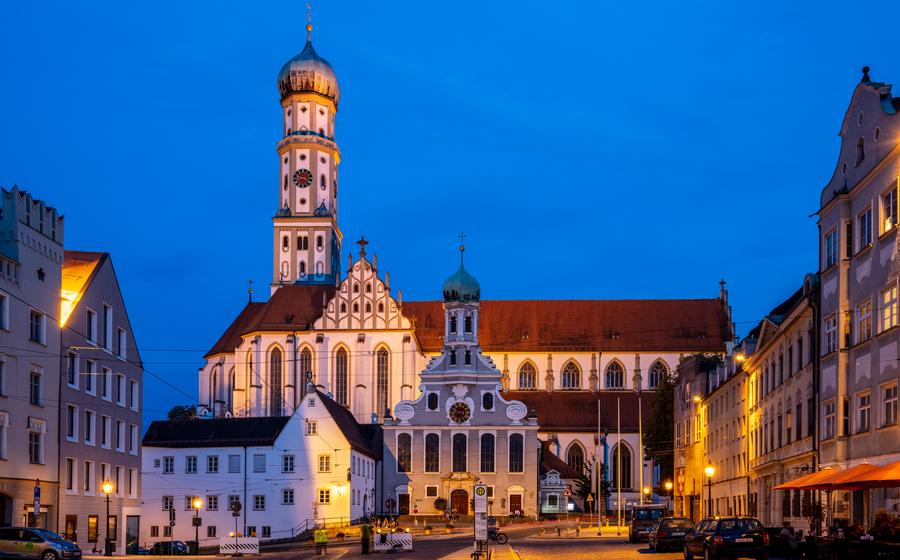
Basilica of SS. Ulrich and Afra
- A Monument to Faith and Resilience
- A Sacred Space
- Artistic Treasures
- A Symbol of Augsburg's Rich History
- Pilgrimage and Tradition
- Exploring the Basilica's Surroundings
- Guided Tours and Audio Guides
- Admission and Opening Hours
- Dress Code and Etiquette
- Accessibility and Facilities
- Events and Exhibitions
- Local Festivals and Celebrations
- Souvenirs and Mementos
- Insider Tip: The Hidden Courtyard
A Monument to Faith and Resilience
The Basilica of SS. Ulrich and Afra stands as a testament to the enduring power of faith and the resilience of the human spirit. Its history is deeply intertwined with the city of Augsburg, and its significance as a religious and cultural landmark cannot be overstated.
Founded in the 8th century, the basilica was built on the site of a Roman basilica dedicated to St. Afra, a Christian martyr. Over the centuries, it has undergone numerous transformations, reflecting the changing architectural styles and the evolving spiritual needs of the community.
In the 16th century, the Reformation swept through Augsburg, and the basilica was converted into a Protestant church. However, following the Peace of Augsburg in 1555, which granted religious freedom to Protestants, the basilica was returned to the Catholic Church.
The basilica underwent a major restoration in the 19th century, during which its original Romanesque style was revived. Today, it stands as a harmonious blend of Romanesque, Gothic, and Baroque elements, showcasing the architectural diversity that has shaped Augsburg's rich history.
Throughout its existence, the basilica has been associated with numerous historical figures, including St. Ulrich, the patron saint of Augsburg, and the Fugger family, a prominent merchant family who played a significant role in the city's development. Their contributions to the basilica's construction and embellishment have left a lasting legacy that continues to inspire and awe visitors to this day.
A Sacred Space
The interior of the Basilica of SS. Ulrich and Afra is a testament to its rich history and spiritual significance. The basilica's layout follows the traditional Latin cross plan, featuring a nave, aisles, transepts, and a choir. The high altar, located at the eastern end of the basilica, is a masterpiece of Baroque art, adorned with intricate carvings and gilded ornamentation. The choir stalls, intricately carved from wood, date back to the 15th century and showcase the skill of medieval artisans.
The basilica's stained glass windows are a symphony of color and light, depicting scenes from the lives of SS. Ulrich and Afra, as well as other biblical figures. These windows, some of which date back to the 13th century, bathe the interior in a ethereal glow, creating an atmosphere of awe and reverence. The spiritual significance of the basilica is palpable, as it has been a place of worship and pilgrimage for centuries. The relics of SS. Ulrich and Afra, housed in a silver reliquary, are a focal point of devotion for pilgrims who come from far and wide to pay their respects.
Artistic Treasures
The Basilica of SS. Ulrich and Afra is a treasure trove of stunning artwork that reflects the artistic brilliance of different periods and styles. The basilica's interior is adorned with magnificent ceiling frescoes that depict biblical scenes and the lives of the patron saints, SS. Ulrich and Afra. These frescoes, created by renowned artists such as Hans Holbein the Younger and Christoph Amberger, are a testament to the artistic prowess of the Renaissance and Mannerist periods.
Intricate sculptures and carvings grace the basilica's columns, altars, and choir stalls, adding a three-dimensional element to the sacred space. The intricate details and lifelike expressions of these carvings showcase the exceptional craftsmanship of medieval and Baroque artisans.
Beautiful paintings and tapestries further enhance the basilica's visual splendor. These works of art depict religious scenes, portraits of saints, and allegorical representations, adding layers of meaning and symbolism to the basilica's interior.
The artistic collaboration between different periods and styles in the Basilica of SS. Ulrich and Afra creates a harmonious blend of aesthetics that is both awe-inspiring and uplifting. Each artwork contributes to the basilica's rich visual narrative, inviting visitors to contemplate the spiritual and artistic heritage of this sacred space.
A Symbol of Augsburg's Rich History
The Basilica of SS. Ulrich and Afra stands as a testament to Augsburg's rich and tumultuous history. For centuries, it has served as a spiritual and cultural beacon, shaping the city's religious and cultural landscape. Its enduring presence through wars, reforms, and societal changes speaks to the resilience and faith of the Augsburg people.
During the Thirty Years' War, which ravaged Europe in the 17th century, Augsburg found itself at the heart of the conflict. The city suffered greatly, with much of its infrastructure destroyed and its population decimated. Amidst this devastation, the Basilica of SS. Ulrich and Afra remained a symbol of hope and resilience, offering solace and comfort to the war-torn community.
The basilica's role as a witness to history extends beyond the Thirty Years' War. Its walls hold stories of Augsburg's triumphs and struggles, of its periods of prosperity and adversity. It has borne witness to the city's transformation from a medieval trading hub to a center of the Protestant Reformation and beyond.
Today, the Basilica of SS. Ulrich and Afra stands as a symbol of Augsburg's enduring legacy. Its blend of architectural styles and its rich history reflect the city's complex and multifaceted identity. As visitors explore this sacred space, they are transported through time, gaining a glimpse into the profound faith and resilience that have shaped Augsburg over the centuries.
Pilgrimage and Tradition
Throughout history, the Basilica of SS. Ulrich and Afra has served as a significant pilgrimage site, drawing countless devotees and faithful visitors from far and wide. The basilica's patron saints, SS. Ulrich and Afra, hold a special place in the hearts of pilgrims, who come to pay homage and seek intercession. Pilgrims often undertake arduous journeys to the basilica, guided by their faith and the desire for spiritual renewal.
The basilica's spiritual significance extends beyond its role as a pilgrimage destination. It is a place where the faithful gather for regular worship services, sacraments, and special events. The basilica's sacred ambiance and rich history create a profound sense of connection with the divine, fostering a deep sense of devotion and spirituality among its visitors.
Pilgrimages to the basilica are often accompanied by specific rituals, traditions, and customs that have been passed down through generations. Pilgrims may engage in acts of devotion such as lighting candles, praying at the relics of SS. Ulrich and Afra, or participating in special processions and ceremonies. These rituals and traditions add to the sacred and communal nature of the pilgrimage experience, creating a sense of unity and shared faith among pilgrims.
The basilica continues to be a vibrant center of pilgrimage and devotion, attracting visitors from all walks of life who seek spiritual guidance, comfort, and peace. The enduring legacy of pilgrimage at the Basilica of SS. Ulrich and Afra is a testament to its enduring spiritual significance and its role as a beacon of faith for generations.
Exploring the Basilica's Surroundings
Strolling through the picturesque streets and squares surrounding the Basilica of SS. Ulrich and Afra is like stepping back in time. The historic buildings, cobblestone streets, and charming cafes create an enchanting ambiance that transports visitors to another era. Just a stone's throw away from the basilica, you'll find the Augsburg Cathedral, an equally impressive architectural masterpiece with its Gothic spires reaching towards the sky.
The Rathaus, or City Hall, is another must-see attraction. This Renaissance building is renowned for its intricate facade, adorned with sculptures and frescoes that depict scenes from Augsburg's rich history. Take a moment to admire the astronomical clock, which chimes and features moving figures on the hour.
Combining a visit to the basilica with a broader exploration of Augsburg's historic center is a delightful way to immerse yourself in the city's cultural heritage. Wander through the narrow alleyways, lined with boutiques, galleries, and traditional German restaurants. Discover hidden courtyards, adorned with fountains and flowers, that offer a tranquil respite from the bustling city streets.
As you explore, savor the vibrant atmosphere of Augsburg's old town. The lively markets, street performers, and outdoor cafes create a sense of energy and excitement. Indulge in local culinary delights, from hearty Bavarian dishes to sweet pastries, at one of the many restaurants or cafes that line the streets. The old town is a feast for the senses, offering a tantalizing blend of history, culture, and gastronomy.
Guided Tours and Audio Guides
The Basilica of SS. Ulrich and Afra offers guided tours in various languages, providing visitors with an opportunity to delve deeper into the basilica's rich history and significance. These tours are led by knowledgeable guides who share fascinating insights and anecdotes, bringing the basilica's past to life. Visitors can choose from a range of tour options, including general overviews and more specialized tours focusing on specific aspects of the basilica, such as its art or architecture.
If you prefer a self-guided experience, audio guides are available in multiple languages, allowing you to explore the basilica at your own pace. These audio guides provide detailed commentary on the basilica's highlights, ensuring you don't miss any of its treasures. Printed guides are also available for those who prefer a more traditional approach.
To make the most of a self-guided tour, it's recommended to do some research beforehand to identify the basilica's must-see features. This will help you prioritize your time and ensure you don't miss any of the key highlights. Taking your time to explore the basilica's nooks and crannies is also worthwhile, as you may discover hidden details or unique perspectives that you might otherwise miss.
Admission and Opening Hours
The Basilica of SS. Ulrich and Afra is open to visitors throughout the year, offering free admission to all. However, donations are gratefully accepted to support the basilica's ongoing preservation and maintenance efforts. Guided tours in various languages are available for a small fee, providing deeper insights into the basilica's history and significance.
To avoid crowds and ensure a peaceful experience, it is recommended to visit the basilica during weekdays or early in the morning. If you are particularly interested in photography, consider visiting during the golden hours of sunrise or sunset to capture the basilica's exterior bathed in warm, ethereal light.
Please be respectful of the basilica's sacred nature and maintain silence while inside. Photography is permitted, but using a flash is prohibited to avoid disturbing other visitors or damaging the basilica's delicate interior.
Dress Code and Etiquette
When visiting the Basilica of SS. Ulrich and Afra, it is important to dress respectfully and appropriately, mindful of the basilica's religious significance. While there is no strict dress code, modest attire is recommended. Avoid wearing shorts, tank tops, or revealing clothing. It is customary to cover your shoulders and knees, especially when entering the basilica's sacred spaces.
To ensure a peaceful and respectful atmosphere, silence and reverence are expected within the basilica. Avoid talking loudly or engaging in disruptive activities. Please be mindful of other visitors who are seeking a spiritual experience. Photography is permitted, but be discreet and avoid using flash or disturbing others. By following these guidelines, you can demonstrate respect for the basilica's religious traditions and create a welcoming environment for all visitors.
Accessibility and Facilities
The Basilica of SS. Ulrich and Afra is committed to accessibility and inclusivity, ensuring that all visitors can experience its spiritual and architectural wonders. Wheelchair accessibility is a priority, with designated areas for visitors with disabilities throughout the basilica. These areas provide unobstructed views of the altar, allowing everyone to fully participate in religious services and admire the basilica's beauty.
Restrooms and seating areas are conveniently located within the basilica, ensuring comfort and convenience for visitors. The basilica also offers a range of visitor amenities, including guided tours in various languages, audio guides, and printed guides. These resources enhance the visitor experience by providing deeper insights into the basilica's history, architecture, and significance.
To ensure a comfortable and enjoyable visit for all, visitors are encouraged to plan their visit carefully. Avoiding peak hours can help reduce crowds, allowing for a more peaceful and contemplative experience. Additionally, respectful behavior and appropriate attire are essential for maintaining the sacred atmosphere of the basilica.
The Basilica of SS. Ulrich and Afra welcomes visitors from all walks of life, fostering an environment of inclusivity and understanding. Its commitment to accessibility and facilities ensures that everyone can fully appreciate the basilica's spiritual and cultural heritage.
Events and Exhibitions
The Basilica of SS. Ulrich and Afra is not only a sacred space but also a vibrant cultural venue. Throughout the year, the basilica hosts a diverse calendar of events and exhibitions that showcase its rich heritage and contribute to the cultural life of Augsburg.
One of the highlights of the basilica's events is the annual Ulrichsfest, held in July. This festival celebrates the life and legacy of St. Ulrich, one of the basilica's patron saints. The festival features a colorful procession, traditional Bavarian music, and a lively market with local crafts and delicacies.
Another significant event is the Friedensfest, held in August. This festival commemorates the end of the Thirty Years' War and the return of peace to Augsburg. The festival includes a solemn Mass, a peace procession, and various cultural performances.
In addition to these major festivals, the basilica also hosts regular concerts, art exhibitions, and lectures. These events provide an opportunity to experience the basilica's stunning acoustics, admire the works of talented local artists, and delve deeper into the basilica's history and significance.
By planning your visit around specific events or exhibitions, you can enhance your experience of the Basilica of SS. Ulrich and Afra and gain a deeper appreciation for its cultural and spiritual heritage.
Local Festivals and Celebrations
The Basilica of SS. Ulrich and Afra is deeply intertwined with the cultural fabric of Augsburg, playing a central role in various local festivals and celebrations throughout the year. Two notable events that draw crowds to the basilica and the city are the Ulrichsfest and the Friedensfest.
The Ulrichsfest, held annually in July, commemorates the life and martyrdom of Saint Ulrich, one of the basilica's patron saints. This vibrant festival features a colorful procession through the streets of Augsburg, with participants dressed in traditional Bavarian attire. The procession culminates at the basilica, where a solemn mass is held in honor of Saint Ulrich.
The Friedensfest, or Peace Festival, is another significant event held in Augsburg in August. This festival celebrates the end of the Thirty Years' War and the return of peace to the city. The basilica is a focal point of the Friedensfest, with special services and events held to mark the occasion.
These festivals offer an excellent opportunity to experience the basilica's cultural significance and witness the deep devotion of the local community. Participating in these celebrations allows visitors to immerse themselves in Augsburg's rich history and traditions, creating lasting memories of their visit to the city and the Basilica of SS. Ulrich and Afra.
Souvenirs and Mementos
A visit to the Basilica of SS. Ulrich and Afra wouldn't be complete without taking home a memento to remember your experience. The basilica's gift shop offers a wide range of souvenirs, from traditional religious items like rosaries and crucifixes to unique gifts like books, postcards, and jewelry inspired by the basilica's art and history.
When choosing a souvenir, consider items that hold special meaning or significance. A small statue of one of the basilica's patron saints, SS. Ulrich or Afra, can serve as a reminder of their lives and sacrifice. A book about the basilica's history or architecture can provide a deeper understanding of its cultural and spiritual significance.
Your purchase of a souvenir not only serves as a personal memento but also supports the basilica's mission. The revenue generated from the gift shop contributes to the basilica's upkeep, restoration projects, and outreach programs. By purchasing a souvenir, you become a part of the basilica's ongoing story and help preserve its legacy for generations to come.
Insider Tip: The Hidden Courtyard
Amidst the grandeur of the Basilica of SS. Ulrich and Afra lies a hidden gem—a serene and secluded courtyard. Step through an unassuming doorway and discover a tranquil oasis, where time seems to stand still. Surrounded by ancient walls and adorned with delicate flowers, this courtyard offers a moment of respite from the bustling city outside. Sit on a bench and admire the intricate details of the basilica's architecture, or simply soak in the peaceful atmosphere. If you're lucky, you may even catch a glimpse of the resident doves fluttering around the courtyard, adding to its charm. This hidden gem is a reminder that amidst the grandeur of this sacred space, there are still places of quiet contemplation and beauty to be found.
